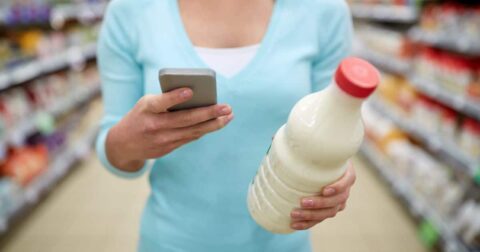Southwest Wisconsin Dairy Operation Linked to Spill Affecting Eight Miles of Trout Waters
Climate•4 min read
Analysis
Milk and meat brands are turning to climate labels like "carbon neutral" and "net zero" to boost sales. But what do these terms actually mean?


Words by Claire Hamlett
An increasing number of food brands are turning to climate labels to boost sales. In the face of research that meat and milk are high in greenhouse gas emissions, companies are angling for new ways to reach eco-conscious consumers. A new report from the Changing Markets Foundation found 53 instances of greenwashing— including carbon neutral milk and beef. But what does it mean and, more importantly, can you trust it?
Research shows consumers do want this information — 39 percent of shoppers have sustainability in mind when they make food purchases. But government agencies provide little to no oversight of these labels. And consumers are woefully under-informed. One survey found that only 46 percent of U.S. consumers believe eating less meat benefits the planet.
Getting a handle on all these labels could help. In this explainer, we take a closer look at the terms “carbon neutral” and “net zero” on meat and milk, and tell you what to look for.
Products that bear the label “carbon neutral” are supposed to be produced with no added emissions to the atmosphere. But can you trust it? It’s complicated.
In order to accurately call your product is carbon neutral, companies have to first start out with an accurate accounting of their emissions — the carbon footprint of every product they make. That’s a problem for the many meat and dairy companies, as most don’t actually know the emissions associated with their full supply chain, including the mega-brands Tyson, Cargill and Smithfield.
Once a company does have an accurate starting point, they can begin looking for places to reduce their pollution. A milk producer could improve manure management on their dairy farm. A restaurant or dining hall could choose to serve a lentil burger over a beef patty. These actions can help draw down emissions, each choice to varying degrees.
Virtually all companies will be left with some emissions after they cut here and there in their supply chains. That’s especially true for products with very high pollution costs like meat and dairy. For example, the amount of greenhouse gases emitted by 100 grams of peas is equivalent to just .44 kg CO₂eq — that’s tiny — but for the same amount of beef, the emissions cost would be a whole lot more at 49.89 kg. That’s a lot to reduce, and impossible if the product itself — beef — is the main source of emissions.
Once a company has made every cut they can, they will then “offset” the remainder of emissions in order to get to a “carbon neutral” status. Producers usually do this by buying carbon credits – an assurance from another company or carbon project that they are reducing or capturing their emissions by the amount the offset purchaser needs.
One of the most well-known examples is tree-planting. The National Forests Foundation advertises that for every $2 donation, they’ll plant two trees that will remove or offset 1 metric ton of CO2e from the atmosphere for the life of those trees.
Now, as long as offsets are properly managed — and we’ll return to that in a minute — they can be incredibly beneficial to the environment. According to Johan Rockström, a researcher with the Potsdam Institute for Climate Impact Research, offsets can be used to restore and grow new forests, protect the oceans and improve agricultural practices to increase soil health.
But back to that proper management part, for offsets to work, they need to meet certain criteria — they need to be additional and permanent – which means they must be removing carbon that would not otherwise be removed without the credit, and must store carbon for a long time so the emissions reduction won’t simply be lost later. If you cut down the trees in ten years, you lose any carbon gains as the gases are released back into the atmosphere.
Figuring out which offsets are valid is tricky. Many offsetting schemes receive third-party certifications but these can also be riddled with fraud. A recent investigation into forest carbon offsets run by Verra, the world’s leading offsetting certifier, and used by companies including Disney, Shell and Gucci found that 94 percent of offsets bought through Verra failed to reduce deforestation or were for forest areas where deforestation wasn’t happening anyway.
Intentional fraud aside, there are also many low-quality carbon projects that are just not actually sequestering carbon. Some of these come from carbon farming for instance, where companies pay for a farm to use “regenerative” practices like no-till and cover crops. Meat giant Cargill estimated it could save 1.7 million tons of carbon by 2030 by getting farmers growing its cattle feed crops to use these techniques. But because the science underlying the carbon farming market is on shaky ground, the offsets may not be valid after all.
Still other carbon offset projects have been found to be damaging to biodiversity and human rights. And yet another wrinkle — climate scientists agree that humans can’t simply offset our way out of the climate crisis. Our emissions are just too high at this point. Rockstrom warns polluting companies need to cut their emissions down by at least half each decade to reach net zero by 2050. Offsets should only play a small role.
Despite the problems, the following meat and dairy producers use the terms carbon neutral or carbon negative on their food labels:
Net zero is similar to carbon neutral — but it’s typically used by companies to indicate an entire field or industry has reduced its emissions. The push to get corporations and industries to strive for “net zero” is part of a larger effort to get major polluters to meet global climate goals agreed to at the 2015 Paris climate conference.
In the UK, the National Farmers Union has a “net zero by 2040” target for the nation’s whole agriculture sector. The U.S. Roundtable for Sustainable Beef claims the U.S. beef supply chain will be carbon neutral by 2040. Meat and dairy giants including JBS, Tyson, Danish Crown, Nestle, Danone, Arla and Fonterra have all made net zero pledges.
The problem with all of these claims is that none of the major meat and dairy companies have plans to reduce the number of farm animals in their supply chains — and it’s the animal farming that causes 90 percent of their emissions. If anything, companies like Tyson and Fonterra are planning to expand meat and dairy production, casting serious doubt on their ability to meet these targets.
Not only that, there is no consistent transparency or metrics from one meat and dairy net zero plan to another. For example, Fonterra reports its emissions from raising and feeding animals on farms in New Zealand but not those abroad, and is relying heavily on technology that could reduce methane from cows to reduce emissions. The company has been accused of underreporting its emissions by about half.
Meanwhile, Tyson says it wants to expand its “current target to verify sustainable beef production practices on more than 5 million acres of U.S. cattle-grazing land by 2025” but it doesn’t share what its current or planned emissions are. These disparities make a big difference in where companies decide to make changes and how they measure their progress.
JBS’s claims were so toothless in fact that the National Advertising Division of the Better Business Bureau recently decided JBS should stop using its net zero by 2040 claims altogether.
There are so many different claims, targets and metrics that consumers have little to no assurance that a “carbon neutral” or “net zero” claim means what it says. What’s easiest — and most accurate — is to eat more foods that are low-carbon to begin with, like a healthy and sustainable diet with mostly nutrient-rich plants on your plate.
This piece has been corrected to reflect that the Greenwashing report was published by the Changing Markets Foundation.